B0041VYHGW EBOK (187 page)
Authors: David Bordwell,Kristin Thompson

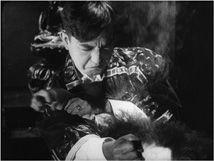
12.10 … that returns later when the villain brands the heroine.
“That evening I tried to increase my knowledge of motion-picture technique by going to the movies. I sat with a stop watch and notebook and tried to estimate the number of cuts or scenes in a thousand-foot reel, the length of individual scenes, the distance of the subject from the camera, and various other technical details.”
— King Vidor, director, recalling the night before he began directing his first film, c. 1912
The period 1909–1917 saw the development of the basic continuity principles. Eyeline matches occur with increasing frequency from 1910 on. The match on action developed at about the same time and was in common use by 1916. It appears in such Douglas Fairbanks films as
The Americano
(1916) and
Wild and Woolly
(1917). Shot/reverse shot was used only occasionally between 1911 and 1915, but it became widespread by 1916–1917; instances occur in such films as De Mille’s
The Cheat
(1915), Hart’s Western
The Narrow Trail
(1917), and Griffith’s
A Romance of Happy Valley
(1919). During this period, films rarely violated the axis-of-action rule in using these techniques.
By the 1920s, the continuity system had become a standardized style that directors in the Hollywood studios used almost automatically to create coherent spatial and temporal relations within narratives. A match on action could provide a cut to a closer view in a scene
(
12.11
,
12.12
).
A three-way conversation around a table would no longer be handled in a single frontal shot. Note the clear spatial relations in
12.13
–
12.17
, shots from
Are Parents People?
(Malcolm St. Clair, 1925). At the time, screen direction was usually respected, as in this case. When an awkward match might have resulted from the joining of two shots, the filmmakers could cover it by inserting a dialogue title.
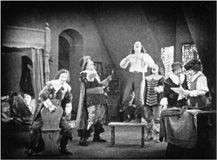
12.11 In Fred Niblo’s
The Three Musketeers
(1921), a long shot of the group leads to …
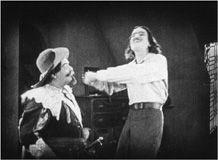
12.12 … a cut-in to the central character, played by Douglas Fairbanks.
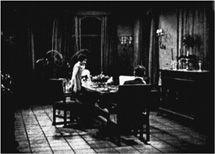
12.13 In an establishing shot from
Are Parents People?
the daughter sits down at the table.
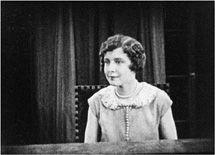
12.14 In the medium shot she looks leftward toward her father …
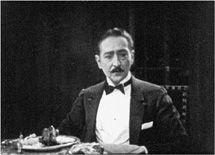
12.15 … who looks rightward at her in the reverse shot.
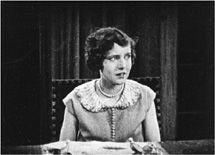
12.16 The daughter then turns to look to the right at her mother …
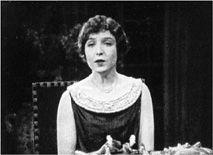
12.17 … who also returns her gaze in reverse shot.
Keaton’s
Our Hospitality
(1923), which we examined in
Chapter 4
, provides another early example of a classical narrative. Keaton’s mastery of classical form and style are evident in the carefully motivated recurrences of the various narrative elements and in the straightforward causal development from the death of Willie McKay’s father in the feud to Willie’s final resolution of the feud.
By the end of the silent era, in the late 1920s, the classical Hollywood cinema had developed into a sophisticated movement, but the Hollywood product was remarkably standardized. All of the major studios used the same production system, with a similar division of labor at each. Independent production was less important. Some independent firms made low-budget films, often Westerns, for small and rural theaters. Even powerful Hollywood stars and producers had trouble remaining independent. Keaton gave up his small studio in 1928 to go to MGM under contract; there his career declined, partly because of the incompatibility of his old working methods with the rigid production patterns of the huge studio. Griffith, Mary Pickford, Fairbanks, and Charles Chaplin were better off. Forming a distributing corporation of their own, United Artists, in 1919, they were able to continue independent production at small companies under their umbrella corporation, though Griffith’s company soon failed, and the careers of Fairbanks and Pickford declined soon after the introduction of sound.
There were alternative kinds of films being made during the silent era—most of them in other countries. After examining these alternative movements, we’ll return to consider the classical Hollywood cinema after the coming of sound.
At the start of World War I, the output of the German film industry was relatively small, though some impressive pictures had been made there. Germany’s 2000 movie theaters were playing mostly French, American, Italian, and Danish films. America and France banned German films from their screens immediately, but Germany was not even in a solid enough position to ban French and American films, for then the theaters would have had little to show.
To combat imported competition, as well as to create its own propaganda films, the German government began to support the film industry. In 1916, film imports were banned except from neutral Denmark. Production increased rapidly; from a dozen small companies in 1911, the number grew to 131 by 1918. But government policy encouraged these companies to band together into cartels.
The war was unpopular with many in Germany, and rebellious tendencies increased after the success of the Russian Revolution in 1917. Widespread strikes and antiwar petitions were organized during the winter of 1916–1917. To promote pro-war films, the government, the Deutsche Bank, and large industrial concerns combined several small film firms to create the large company UFA (short for Universum Film Aktiengesellschaft) in late 1917. Backed by these essentially conservative interests, UFA was a move toward control of not only the German market but the postwar international market as well.
